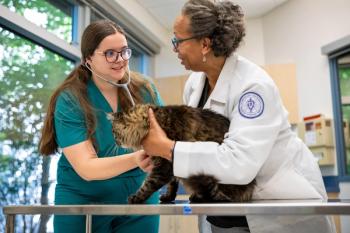
The nuts and bolts of pet health insurance
Sarah Wooten, DVM: Hello and thank you for joining this dvm360 Pet Connections discussion. I’m your host, Dr. Sarah Wooten.
According to the North American Pet Health Insurance Association, or NAPHIA, pet health insurance has been available for more than a century. In the United States, the pet insurance market has been on an upward trajectory since the first U.S. insurer, VPI, opened its doors in 1980.
During our time together, we’ll discuss the rise of the pet insurance industry, how pet insurance works, and what benefits it offers to pets and their owners, and veterinary practices, and how to introduce it in your hospital.
Our experts today are two licensed veterinary technicians: Bash Halow, a certified veterinary practice manager and business management consultant, and Danielle Russ, the Hospital Administrator at the Center of Veterinary Expertise in Suffolk, Virginia.
Also joining us later in the program is Kevin Kassover and his dog Leo. Kevin will share his experience with pet insurance from the pet owner’s perspective.
Thank you for joining us here on Pet Connections. Let’s begin.
Dr. Wooten: Bash, can you provide a brief overview of the history of pet insurance?
Bash Halow, LVT, CVPM: I thought you did a great job of it. It started out in 1980 with VPI, and I think all of us remember going to conferences and VPI was everywhere. They were a great sponsor at veterinary conferences and at veterinary educational events in general, and they wrote their first policy in 1982, for a dog, this is true, I don’t know if you know this, the dog’s name was Lassie.
Dr. Wooten: I did not. I was six when that happened.
Mr. Halow: Okay. I beat you out a little bit in the age department. That’s the overview. Now, there are about 13 companies that provide pet insurance in America. There are more that are starting up but those are the ones that are established.
Dr. Wooten: What is the current market uptake and the projected market value?
Mr. Halow: Its impressive. In the United States in 2017 the industry wrote $1 billion worth of policies. There are currently 13 companies that are working in America that have been established. There are more that are just starting out now, so it’s a big industry.
Dr. Wooten: Danielle, what types of pet insurance are available?
Danielle Russ, BS, BA, AS, LVT: There's a wide range of policies available that really can fit for any pet owner. You have policies that include wellness and preventive care along with catastrophic care. You have insurance policies primarily just for catastrophic care or chronic illness. You also have a sliding scale of percent reimbursement, and some allow adjustable deductibles, so that will affect your monthly premium in order to lower that for you, if that’s more in your budget. You also have opportunities to look at whether they have lifetime payouts or annual payouts, just so you can plan and fit in your budget and for your lifestyle for your pet.
Dr. Wooten: How does it work? What is covered, what is not covered? How do premiums work, things like that?
Ms. Russ: With all the different companies, that’s where you're going to do a little bit of your homework and find what works best for you, though the majority of them are moving to whether you have an annual or an incident deductible and then that is going to affect then your monthly payment and then you have a sliding scale of that percent reimbursement. Most of them are moving to a 90% reimbursement. The majority of things are going to be covered. Of course, the sooner you get your policy in place, the more things are covered. There are even those that will cover preexisting conditions. It is going to vary between the companies.
Ideally you get that policy as soon as possible but even if your pet has had potentially an injury you can still get pet insurance, and it’s going to continue to cover them going forward. There are sometimes waiting periods on certain conditions but once that condition has been cleared, such as an ear infection, after a year waiting period, you can potentially then have that covered if it comes up again.
Dr. Wooten: Danielle, what about preexisting conditions?
Ms. Russ: In most cases, they’re not going to be covered. It’d just be best to get your insurance policy in place as soon as possible.
Dr. Wooten: If I’m a pet owner, how do I figure out how much the premiums and deductibles are for dogs or cats?
Ms. Russ: There are many websites that will do a comparison for you. You go in, you select your pet’s breed, age, and what your ideal deductible would be, and then it will go ahead and bring up a comparison list for you. You can also call the companies direct.
Dr. Wooten: What is the ballpark difference between insurance on a dog versus a cat?
Ms. Russ: Cats are typically less per month than dogs.
Dr. Wooten: Do premiums rise as pets age?
Ms. Russ: Age does play some factor, but again depending on the company is whether how much that weighs in. The primary factors are your breed, as well as where you live. Those are some of the big factors on what your monthly payments are going to be.
Dr. Wooten: Thank you. Bash, what do you see as the most common conditions in dogs for which pet insurance claims are made?
Mr. Halow: It’s all the things that we always see at practices, in general practices every day. Its ears, it’s skin, it’s diarrhea and vomiting and its typically noncancerous mass removals. Those are the top ones.
Dr. Wooten: Is it the same for cats or is it different?
Mr. Halow: A little different. With cats you add dentistry, that’s a big thing. There’s often dental disease with cats. There are also skin issues and of course vomiting, diarrhea and cystitis, and urinary issues, that’s also a big thing.
Dr. Wooten: Absolutely, that FIC gets you very time.
Newsletter
From exam room tips to practice management insights, get trusted veterinary news delivered straight to your inbox—subscribe to dvm360.





